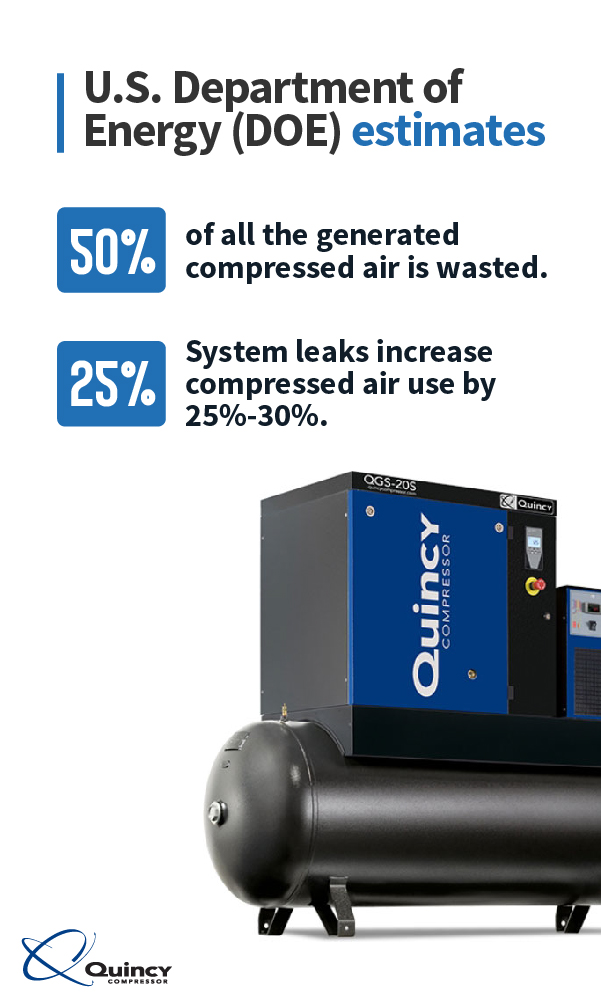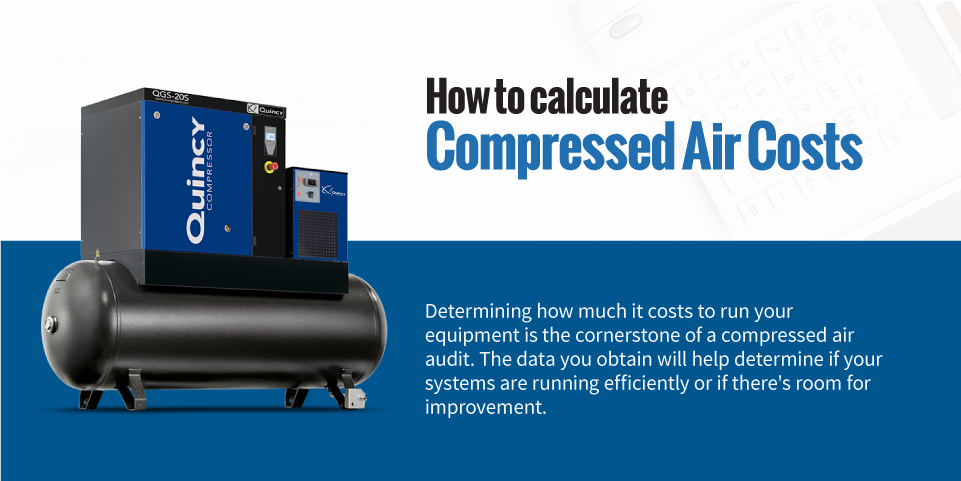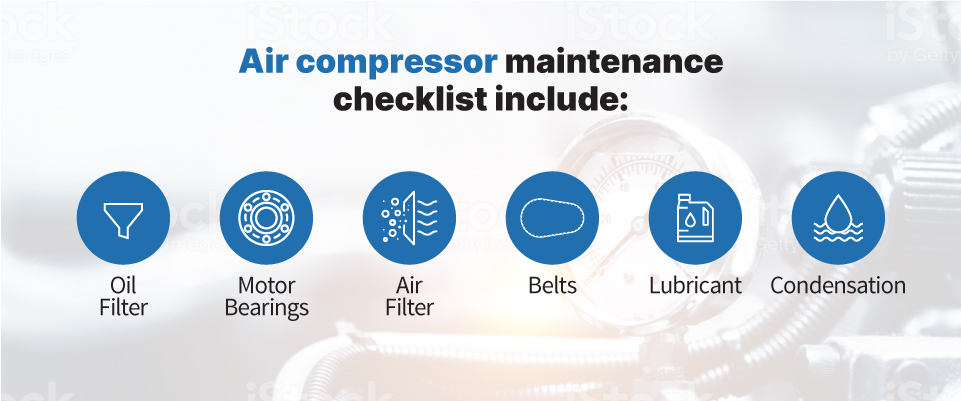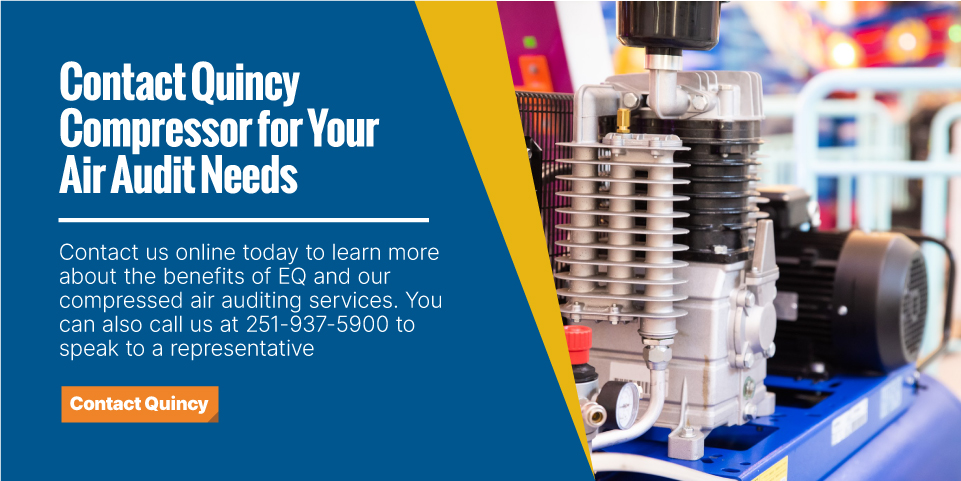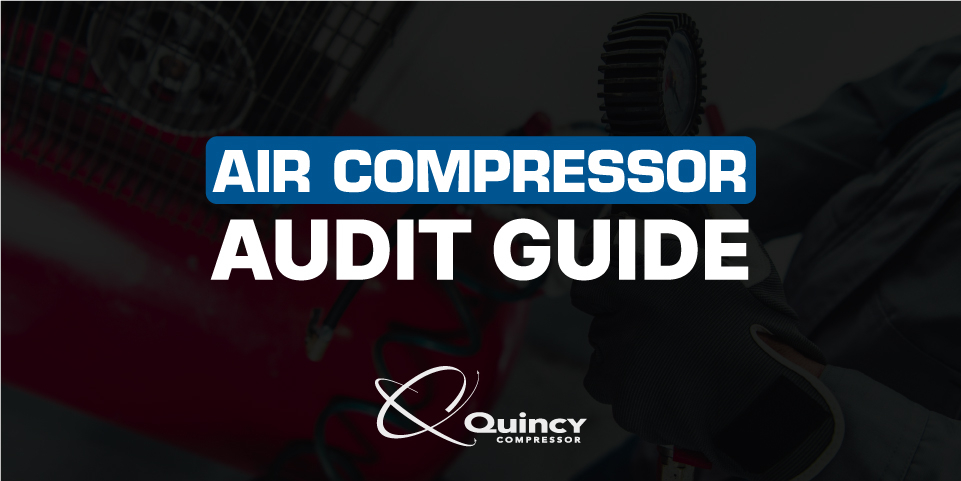
Air compressors perform a crucial function for businesses in industries like manufacturing, automotive, construction, energy exploration and many others. While air compressors are essential, they consume substantial energy and can create a significant business expense.
Performing regularly scheduled air audits is necessary for ensuring your systems are functioning properly and reducing your company’s short- and long-term compressed air costs. They can also help you get the most out of your equipment and prolong its life span.
Quincy Compressor has prepared the following air compressor audit guide that explains the process and how it benefits your business.
Why Conduct a Compressed Air Audit?
For many companies, the best reason to conduct regular compressed air audits is to lower energy costs.
For perspective, the U.S. Department of Energy (DOE) estimates that up to 50% of all the generated compressed air is wasted. The DOE also points out that system leaks increase compressed air use by 25%-30%.
When you consider that compressed air comprises approximately $5 billion per year in energy costs, it’s easy to see how an inefficient or malfunctioning system can cause your company’s utility bills to increase to unhealthy levels. The issue is even more concerning for businesses that depend on multiple compressed air units.
Performing a compressed air system assessment enables you to identify issues causing an energy loss and increasing your expenses. Your maintenance team — or an experienced air compressor equipment supplier like Quincy Compressor — can perform troubleshooting steps and make repairs to eliminate waste and save money.
Other air audit benefits include:
- Increase system reliability: An air compressor that’s out of commission can significantly impact your processes and possibly put your projects behind schedule. Audits enable you to identify and correct mechanical issues in the early stages. You’ll have fewer concerns about unproductive downtime and reduce your long-term operating expenses.
- Extend equipment life span: Purchasing new air compressors can create a substantial business expense. By helping you to locate and fix problems, an audit can keep your systems in peak operating condition. Your equipment will last longer, and you won’t need to replace it as frequently. You’ll also maximize your return on investment.
- Identify opportunities for improvement: An audit can often reveal if compressed air equipment is serving its intended purpose or if it meets the company’s operating requirements. You’ll discover whether your current setup meets your needs or whether a system upgrade will deliver a more cost-effective long-term solution.
How to Calculate Compressed Air Costs
Determining how much it costs to run your equipment is the cornerstone of a compressed air audit. The data you obtain will help determine if your systems are running efficiently or if there’s room for improvement.
Determining How Many Kilowatt Hours Each Compressor Is Consuming
The first step is to calculate how much electricity your air compressors consume, which requires figuring the number of kilowatt-hours (kWh) used
Follow these steps to determine yours:
- Determine kWh generated: Start by determining the number of kWh each compressor operates throughout the day — only to count the time the system is running and not the downtime. Complete this process every day for one week to ensure the most accurate results.
- Find power consumption: Check the nameplate on the compressor to determine how much power it is consuming while operating. If you can’t find this listing, you can calculate it by multiplying the unit’s volts and amps to attain the wattage rating.
- Calculate total kWh: Calculate the total number of kWh each compressor has used by multiplying the compressor usage hours by wattage rating and dividing by 1,000. For example, if you operate a compressor for 5 hours per day and the wattage rating is 2,000, the result would be 10 kWh per day.
- Determine daily expenses: Finally, you’ll need to determine the daily cost per kWh by multiplying the kWh per day by the power company’s rate. Using the above example of 10 kWh, if your utility service provider charges 12 cents per hour, the daily cost would be $1.44.
Calculating Your Annual Costs
Once you’ve determined the kWh, you’ll need to spread this figure over an entire year to discover your annual compressed air costs. You’ll need to perform this calculation on a full-load and partial-load basis and add the two figures to obtain the total yearly cost.
Compressed air costs are much higher than companies assume. For many businesses, the result serves as motivation for developing a strategy for reducing these expenses.
How to Conduct an Audit
Quincy’s Engineered Audit uses an eight-step approach. A typical analysis requires one week or less of onsite time and consists of the following procedures:
- Analyze Supply Equipment
- Measure Storage Capability
- Qualify Air Demand
- Resolve Production Problems
- Create System Diagrams
- Determine Operating Costs
- Develop Action Plan
- Provide Complete Report
For more information, visit our EQ Efficiency Quotient.
The process of executing a thorough compressed air audit consists of the following steps:
Perform a Comprehensive Site Survey
Before you can conduct a compressed air audit, you need to understand your system and the equipment that comprises it.
A site survey performed by a professional with extensive compressed air expertise will yield the most reliable results. This knowledgeable individual can determine if you’ve placed your compressors properly and assess the overall system dynamics.
Specific factors the auditor should note during the survey include:
- Location: The location of your compressors in relation to your facility’s layout.
- Environment: The environmental conditions that can impact equipment performance like heat, moisture and humidity.
- Components: The details regarding the various compressed air system components.
- Documentation: The documentation of all processes relevant to your facility’s compressed air applications.
Check for Leaks and Other Issues
As air compressor leaks are a primary culprit of excess energy consumption and associated higher costs, checking for them should be a top priority on any compressed air audit checklist.
Even a small hole in a pipe or hose can raise utility costs by $1,000 per year or more. In compressed air systems, other areas where leaks are prevalent include drain valves, couplings, fittings, manifolds and pneumatic tool ends.
Air pressure drops are another potential sign that your equipment isn’t functioning at maximum efficiency and possibly wasting energy. Solutions for this issue can include installing piping with a narrower diameter and shortening the distance between the compressor and the air end.
Examine Air Filters
Air filters perform the crucial role of preventing contaminants from entering the unit.
Over time, dirt, oil and debris can clog the filters, allowing poor-quality air to pass through the system. Consequently, the equipment will need to work harder to deliver pressurized air on demand. You’ll likely experience more frequent repair issues and a shortened air compressor life span in this scenario.
An audit should include checking all filters and recommending cleaning or replacement as needed. Installing high-efficiency line filters compatible with your air compressor model will deliver the most reliable long-term filtration results.
Detect Artificial Demand
Artificial demand occurs when a compressed air system operates at a higher pressure than necessary, typically to compensate for leaks or flow fluctuations. This extra demand causes the compressor to work harder, resulting in energy waste and increasing the risk of equipment damage.
Compressed air audits can determine if artificial demand exists and its impact on your operating costs.
A professional auditor can recommend the most reliable and cost-effective solution to ensure your compressors function at the lowest possible pressure point without affecting system performance, such as by installing a pressure regulator or flow controller.
Assess Air Dryer Compatibility
The compressed air process generates a substantial amount of heat and condensation that can eventually damage the equipment.
Dryers perform the critical function of cooling the air and removing moisture. However, to get the full benefit from your air dryer, it must be compatible with your air compressor. Otherwise, you’ll end up wasting money by using a dryer that has to work too hard or perform a task that doesn’t meet its functional requirements.
A knowledgeable auditor can determine if you’re using the best equipment for your facility’s unique compressed air system configuration and make recommended upgrades if necessary.
Evaluate Storage Capacity
The more compressed air your system can store, the less frequently your compressors will need to operate. The result is more efficient equipment that lasts longer and requires fewer repairs and substantial cost savings for your business.
An audit can determine if your compressor’s tanks provide sufficient storage capacity for your applications.
If not, there are several options for increasing it. For example, it may be possible to couple two tanks to create a larger reservoir. If the compressor is a reciprocating unit, the air produced by the piston can flow through a connected tube into the tanks.
Optimize the Operating Schedule
Many companies fall into the habit of running their air compressors when they don’t need them. Some even leave them on during weekends or other times when the facility is empty.
The simple step of shutting down compressors during off-hours can result in substantial energy savings and reduce the burden on your equipment.
Implementation
Compressed air audits offer little value if the company doesn’t implement the auditor’s recommendations.
It’s important to develop a strategy for making upgrades in the most cost-effective manner. You should also schedule a follow-up audit after making the changes to assess their effectiveness.
Executing the plan should help you achieve the desired outcome: Bringing power consumption in line with efficient compressed air usage. If this occurs, the audit will more than pay for itself.
The Importance of Keeping a Maintenance Schedule
Air compressors work hard, often in challenging conditions. Performing preventive maintenance is crucial for ensuring your equipment will perform flawlessly when you need it. It will also help you avoid unexpected mechanical breakdowns and prolonging your compressors’ life span.
Air compressor maintenance isn’t expensive — it only encompasses approximately 5%-10% of all annual compressor-related expenses. This small cost will yield a substantial return on your investment by reducing the likelihood of unproductive equipment downtime.
Consider several factors when deciding which compressor maintenance steps to follow and how frequently you should perform them:
- Compressor number and type
- Installation conditions
- Usage frequency and procedures
- Cooling system type
- System safety requirements
- Auxiliary equipment usage
Examples of the items that should be on your air compressor maintenance checklist include:
Oil Filter
Unless you use oil-free air compressors, you’ll need to frequently check and change the oil in your units. Dirty or weak oil can damage your equipment and possibly impact the outcome when performing processes that involve corruptible surfaces.
You should check the oil filters for clogs and other impediments in your compressors weekly and replace them at the recommended intervals. Depending on the compressor manufacturer, equipment type and usage patterns, the preferred time frame could range from 4,000-8,000 hours.
Air Filter
Clogging is only one issue that can occur with a compressor’s air filters.
Even if they look clean, the material can degrade over time, preventing them from functioning properly. Change the filters at the frequency recommended by the manufacturer and even more often in heavy-use applications and environments.
Lubricant
Air compressors consist of numerous metal parts and components.
Lubricant is essential for preventing friction that can lead to mechanical failures and shorten the equipment’s life span. It can also stop the formation of rust that ultimately corrodes crucial parts and joints.
Check the lubricant levels in all your air compressors every six months or more frequently in heavy-use environments. Wipe off any old lubricant and apply a fresh coat as needed. You should also replace the separator element every time you perform a lubricant change.
Motor Bearings
The ball bearings inside the air compressor’s motor rub against each other and the walls of the encasement that houses them.
Without proper lubrication, these bearings can begin to rust and stick together, eventually leading to motor failure. Your air compressor maintenance checklist should include greasing the bearings every 4,000 hours and inspecting them quarterly to ensure they have enough lubricant.
Belts
Belts are crucial for the smooth operation of an air compressor’s internal mechanisms.
A defective belt could snap during the middle of a job and bring the work to a standstill. Your maintenance tasks should include checking the belt tension weekly and making adjustments as needed. You should also inspect the rubber that comprises the belts to detect signs of wear or cracks.
Condensation
As a compressor cools down, the removal of moisture from the compressed air can cause condensation to accumulate. The result can be reduced air quality and the formation of rust on the internal electrical circuits and components.
Excessive moisture at entry points such as dryers and tanks can also allow sludge to develop. Operating the equipment in humid environments can exacerbate the situation.
An air compressor maintenance technician can detect the presence of condensation and remove it before it damages the equipment.
Contact Quincy Compressor for Your Air Audit Needs
When you choose Quincy Compressor to conduct compressed air audits at your facility, you get access to our advanced Efficiency Quotient (EQ) process. Use it to evaluate the efficiency and performance of all your equipment by following a set of industry-approved best practices.
This award-winning three-pronged approach can help you get an accurate estimate of your company’s compressed air costs and target areas for possible improvement. You can also calculate your potential cost savings and how they can impact your budget.
Contact us online today to learn more about the benefits of EQ and our compressed air auditing services. You can also call us at 251-937-5900 to speak to a representative.


